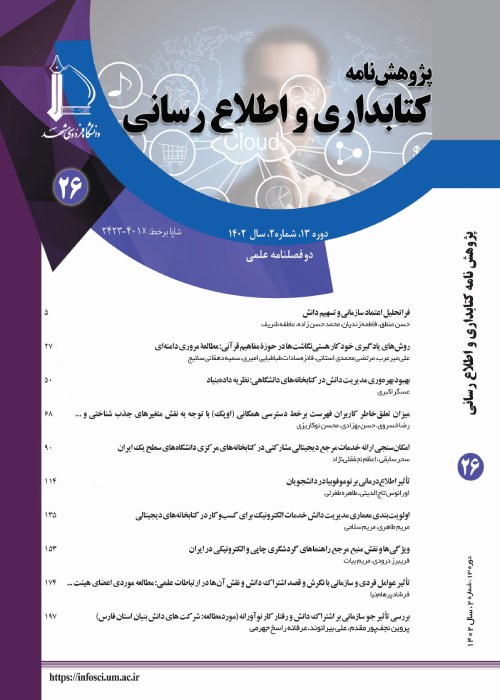Proposed Performance Indicators to Improve Information Literacy based on the Basics of Visual Literacy in Academic Libraries
Information literacy involves an understanding of how information is created, accessed, shared and valued and the abilities and mindset necessary to be able to locate, evaluate, use and create information sources ethically and effectively. On the other hand, visual literacy is a set of abilities that enable an individual to effectively find, interpret, evaluate, use and create images and visual media. Visual literacy is important because it is a basic skill to help us understand and learn about the world around. The academic libraries advocate the alignment of visual literacy and information literacy competencies as a method for connecting multiple literacies in information literacy instruction. Information literacy relies on a productive concurrence of different types of literacies, including visual literacy. Many academic libraries spend a considerable amount of time helping their users develop information literacy competencies. Most applications of information literacy do not include visual literacy elements. Emerging applications such as transliteracy and metaliteracy do incorporate aspects of visual literacy, but these applications have not yet become mainstream information literacy approaches. The aim of this study was to examine the impact of visual literacy component to enhance information literacy in university libraries.
Method of this study was a combination of library method, Delphi and survey and its type is applied. The research approach is also quantitative. The statistical population was 9 members of the faculty members from different universities and institutions of higher education who were top experts familiar with the basics of information and visual literacy in the Delphi panel. The final proposed performance indicators were extracted from the Delphi panel. In the validation phase, 30 undergraduate and PhD students in knowledge and information science in Islamic Azad University, Hamadan Branch were involved. The research tool was a researcher-made questionnaire. The validity of the questionnaire was assessed by formal validity method and Cronbach's alpha coefficient was used for reliability which was equal to 0.73.
Important components of the proposed performance indicator model of visual literacy include visual cognition skills, evaluation of visual resources, use of visual resources in the reference section, evaluation of the nature of information, identification of keywords of visual exploration, control of visual domain terms, matching visual search results, formulation of strategies, exploring visual information, determining appropriate image evaluation criteria, detecting visual source errors, organizing visuals in research, developing search processes, evaluating and transmitting visual information, use of information technology to produce appropriate image, modifying and editing images, production and presentation of appropriate graphics, better representation of visual images, observance of security and confidentiality of images, free access to visual resources, legal use of visuals, respect for copyright in the use of images, prevention of plagiarism of visuals and observance of accurate and complete citations in the use of visual resources.
The results showed that all the performance indicators proposed by experts, master and Ph.D. students have an effective role in improving professional activity in accessing visual information resources in academic libraries and can help users in better retrieval and use of images and visual media. Designed model and its test showed that all the results of seven standards of visual literacy have a positive effect on the enhancement of information literacy. According to the obtained results, it is suggested that short-term visual literacy training courses for students and professors are held in universities and higher education centers to strengthen the skills of exploring, acquiring and using visual items among them. Also, in university libraries, attention is paid to strengthening the visual literacy skills of librarians and information science specialists and to familiarize them with its standards and elements. For the reference librarians, the methods of using images and visual media are explained and the necessary techniques are taught to them. Also, international regulations for the use of images and visual formats should be observed. Guidelines for the application and use of visual media based on intellectual property rights and copyright should be developed in university libraries. Appropriate operational exercises to achieve visual items, production of visual resources, visualization methods, evaluation of images, appropriate use of visuals and visual needs assessment methods should be considered for information science specialists in libraries.
- حق عضویت دریافتی صرف حمایت از نشریات عضو و نگهداری، تکمیل و توسعه مگیران میشود.
- پرداخت حق اشتراک و دانلود مقالات اجازه بازنشر آن در سایر رسانههای چاپی و دیجیتال را به کاربر نمیدهد.



